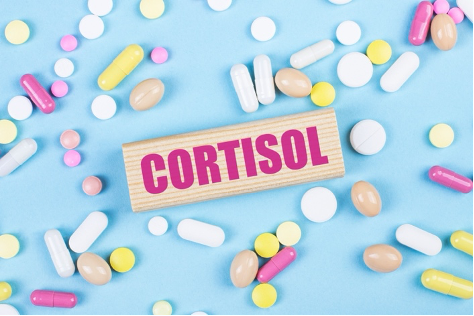Blog
Blog

By Latrenia Ceasar
•
04 Jan, 2024
I’ve had this conversation with several women over 40. They all have had the same concern, hormone levels. These concerns come from feeling tired, not being able to lose weight, not being able sleep at night and so on. Cortisol is considered a stress hormone, but it is associated with many other functions that controls how our bodies function. First, let’s talk about how our body makes cortisol, how it functions in our body, and how to manage it with specific, evidence-based strategies. Cortisol is a steroid hormone produced by the adrenal glands, which are situated on top of each kidney. This is a hormone that is produced by both women and men. It is a big deal as it plays a crucial role in various bodily functions, including metabolism, immune response regulation, and blood pressure maintenance. As you can understand, cortisol is essential for our daily physiological processes. However, it is necessary to note that its levels can fluctuate in response to stress. The Stress Connection is R-E-A-L! In times of stress, the body's "fight or flight" response is triggered, leading to an increase in cortisol production. This heightened cortisol level helps the body prepare to face challenges by mobilizing energy stores and suppressing non-essential functions, such as digestion and immune response. However, chronic stress can lead to prolonged elevated cortisol levels, potentially causing detrimental effects on health. Some of the huge, but negative ways in which cortisol impacts our health include, cognitive function, sleep disturbances, weakened immune system, and yep-you guessed it, weight gain! To look at these a little closer, persistent high cortisol levels are linked to increased abdominal fat deposition, contributing to weight gain. This association has led to cortisol being dubbed the "belly fat hormone." When stress is prolonged or not managed, our immune system Unfortunately, cortisol suppresses the immune system, making the body more susceptible to infections and illnesses when stress is prolonged or not properly managed. Cortisol also disrupts the natural sleep-wake cycle, leading to difficulties falling asleep or staying asleep at night. Cognitive Function: Prolonged stress and elevated cortisol levels may impair memory and concentration, affecting cognitive performance. Even with all these challenges, there are specific strategies to manage cortisol levels. For example, by making a few changes in our behavior when it comes to food we put in our bodies, physical activity, peaceful mindset. But, there’s hope! Regular Exercise: Physical activity helps regulate cortisol levels and promotes overall well-being. Aim for a mix of aerobic and strength-training exercises. Adequate Sleep: Prioritize a consistent sleep schedule to ensure your body has sufficient time to rest and recover. Mindfulness and Relaxation Techniques: Practices such as meditation, deep breathing, and yoga can help reduce stress and lower cortisol levels. Balanced Nutrition: Eat a well-balanced diet with a focus on whole foods. Avoid excessive caffeine and sugar intake, as these can contribute to cortisol spikes. Social Connections: Maintaining strong social ties and seeking support from friends and family can buffer the effects of stress. Conclusion: While cortisol is a vital hormone with essential functions in the body, it's crucial to maintain a balance to ensure overall health and well-being. By adopting lifestyle habits that promote cortisol regulation, individuals can navigate the challenges of daily life more effectively and enhance their resilience in the face of stress. Remember, cortisol isn't solely an adversary; understanding its role allows us to harness its power for optimal health. ~The Coach

By Latrenia Ceasar
•
11 Oct, 2023
Almost twenty years ago, I got the news that my favorite aunt was diagnosed with breast cancer. At the time, I had seen information about breast cancer on television and in magazines, but it had never hit me in the face like this. Even though I was an adult grown woman, I was uneducated on this subject. Unfortunately, to simply put it, I did not know what it meant. I did not know about treatments, complications, risk factors, specific diets, and most importantly, survival. Honestly, neither did my aunt. She was old school and grew up in a time where being educated about anything of value was a luxury. My precious aunt Ruby passed away from this life in 2009. According to the American Cancer Society, breast cancer is the most common type of cancer that develops in women in the U.S., other than skin cancer. As a matter of fact, 1 in 8 women will be diagnosed with breast cancer in their lifetime. Breast cancer, although rare, can also affect men. While the exact causes of breast cancer remain debatable, there are several risk factors and warning signs that are important to be educated on to early detect and prevent breast cancer. So, let’s get down to it. What is Breast Cancer? Breast cancer initially forms when cells in the breast begin to grow abnormally, forming a tumor. It is necessary to note that normally, breast cancer is detected through screening. These cancerous cells can spread to other parts of the body if left untreated. There are several risk factors, such as: Gender: Women are more likely to develop breast cancer than men. Age: The risk increases with age, especially after 50. Family History: Individuals with close relatives who have had breast cancer are at a higher risk. Genetics: Inherited genetic mutations, such as BRCA1 and BRCA2, can increase the risk. Lifestyle Factors: Obesity, lack of physical activity, excessive alcohol consumption, and hormone replacement therapy can also impact the risk. Knowing what the warning signs are can aid in early detection. However, everyone is different. There are some cases where breast cancer can’t be prevented, such as genetics. Some of the steps below can not only help with early detection but may also help with prevention. Lump in the Breast: Most breast lumps are not cancerous, but they should be evaluated by a healthcare professional. Changes in Breast Size or Shape: Any noticeable change should be examined. Changes in the Skin: Redness, dimpling, or puckering of the skin on the breast. Nipple Changes: Such as inverted nipples, discharge, or pain in the nipple area. Breast Pain: While most breast pain is not linked to cancer; persistent discomfort should be investigated. Regular Screenings: Annual mammograms and clinical breast exams can aid early detection. Healthy Lifestyle: Maintain a healthy weight, exercise regularly, limit alcohol consumption, and avoid smoking. Breastfeed, if possible: According to the CDC, breastfeeding has been linked to a reduced risk of breast cancer. Talk with your family: If there is a family history of breast cancer, talk to a healthcare provider about the risks and potential preventive measures. Breast Self-Exams: Regularly check for any changes in your breasts and report them to your healthcare provider. What I would like to end with is that although breast cancer can be a health concern for everyone, awareness, education, early detection, and a healthy lifestyle can make a huge impact at screening times. Understanding the risk factors, recognizing warning signs, and taking proactive steps towards prevention and regular screenings are vital in the fight against breast cancer. Always consult healthcare professionals for personalized guidance and screenings to ensure early detection and effective treatment. With continued research and awareness, improved treatments, and better outcomes for those affected by breast cancer remain hopeful. ~The Coach

By Latrenia Ceasar
•
05 Sep, 2023
Nutrition is the process of consuming nutrients through food or food substances that supply our bodies with benefits such as growth support, energy, reproduction, the repairing of cells, healthy digestion, and so on. However, in cases where inadequate or imbalanced nutrition exists, these benefits turn into heart disease, diabetes, high cholesterol, cancer, and obesity. September is National Childhood Obesity Awareness Month. Let's look at some hard facts. According to the USDA, about 74% of adults are either overweight or obese. Of this percentage, adults aged 40 to 59 have the highest rate of obesity among adults. Unfortunately, 40% of children and adolescents are also either overweight or living with obesity. The percentage of children and adolescents will eventually increase throughout childhood and even into the teen years if it's not corrected at an earlier stage in life. Trying to answer the question of where obesity comes from is quite complex. Obesity results from our weight being above average of what is considered healthy. But what is healthy, and according to whom? The simplified answer is that obesity forms when our bodies consume more calories than they expend over time. Inadequate sleep, low physical activity, overeating, and some medications can contribute to weight gain. Why do we sometimes consume more calories than we expend? A lot of times, we eat based on our emotions. For example, when we are sad, depressed, and even on joyous occasions, like at family gatherings or parties, we eat without paying attention to the food, as we are caught in the moment. Regardless, healthy nutrition only works when we pay attention to what we eat. Ask at least four people you know if they read every nutrition label on the food they buy. Ask another four people if they count the number of calories they consume or expend daily. Generally, the answer will be no to both questions. What does this mean to our health? How we feel and what we see when we look at ourselves reflect what we put in our bodies. So, how can we avoid being in those high percentages mentioned earlier? First, we as adults must work on ourselves so that we can help our children. Pay attention to the food labels. Only eat the suggested servings, as it will avoid overeating. Next, get more active in your daily lifestyle! According to the U.S. Department of Health and Human Services, adults should aim for at least 150 minutes of moderate-intensity or 75 minutes of vigorous-intensity aerobic activity per week. Studies have shown that anxiety, depression, and even high blood pressure are all related to obesity. Just a tiny amount of physical activity can lower blood pressure, reduce anxiety, improve sleep, and more. Fortunately, fitness professionals like me, dietitians, and other qualified licensed professionals can create and help set and manage realistic nutrition and/or fitness goals that end in positive results. Contact me today, and let's go to work! ~The Coach Reference: Physical Guidelines Activity Report. (2018). Part. A. Executive Summary. https://health.gov/sites/default/files/2019-09/02_A_Executive_Summary.pdf

By Latrenia Ceasar
•
04 Jul, 2023
The natural way we move our bodies is guided by three systems. They are the Nervous System, Skeletal System, and Muscular System. Although these systems are distinct, they work synonymously to produce the Human Movement System. Kinetic energy is the work our bodies generate while moving. When we exercise, our bodies are in a constant state of motion while performing each repetition of movement. Where there is improper movement, there is also inappropriate performance of an exercise. When this happens, it can ultimately lead to injury, exhaustion, and other unwanted conditions. So, what does this mean? During a Kinetic Chain Assessment, a fitness professional will look at five checkpoints on the body to ensure that proper posture, form, and technique are achievable. The five checkpoints are: 1. Head and cervical spine 2. Shoulders 3. Lumbo-Pelvic-Hips Complex 4. Knees 5. Feet and ankles During an assessment, the whole-body movement is under review by your trainer. However, these checkpoints are essential, as they all work as one interconnected unit. Although they are all connected, too much strain in one region or joint will cause another region or joint to overwork. This extra work will trigger those unwanted conditions mentioned earlier. For example, when performing a Single-Leg Hip Rotation, the rotation should be through the hip of the balance leg. Rotating only the hip will enhance better control and stability of the core. When this exercise is performed incorrectly, the spine may rotate. When the spine is rotated instead of the hip, it may cause unwanted stress on the spine. Movement assessments like the KCA are essential as they allow your fitness professional to assess your fitness level and strategically develop a fitness program suitable for your specific needs. So, let’s Kinetically Check Your Fitness! For more information or to schedule an appointment please visit our contact page. ~The Coach
Service Areas
Little Rock, North Little Rock, Jacksonville, Maumelle, Bryant







